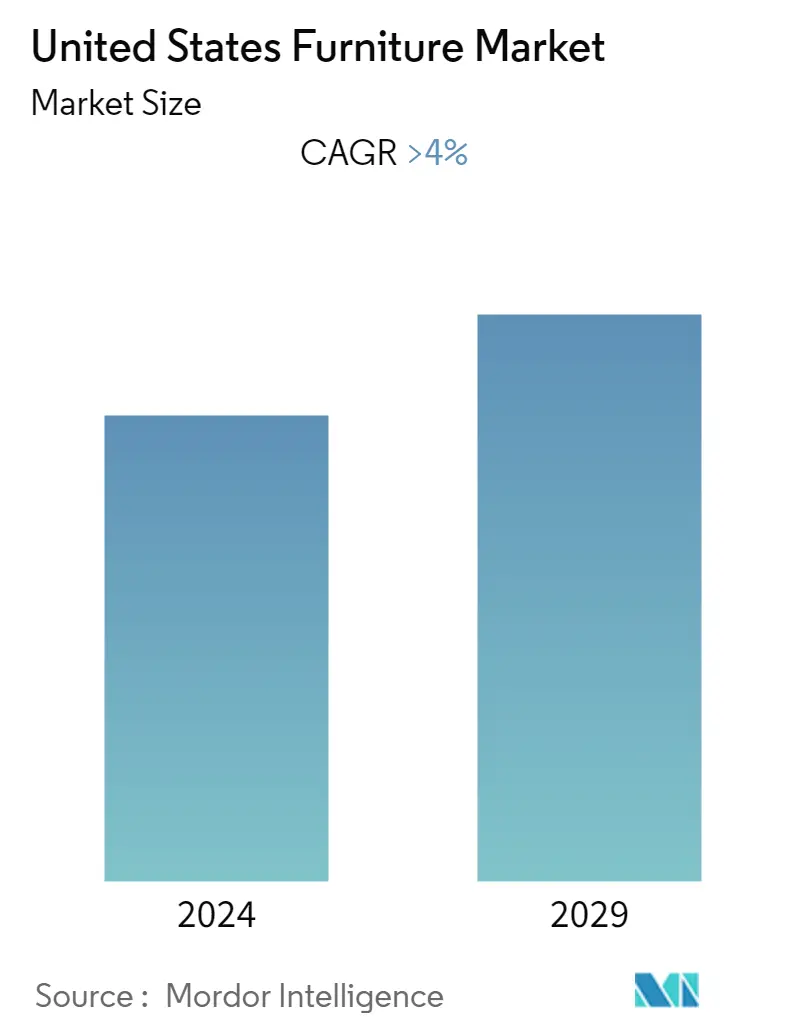Market Size of United States Furniture Industry

| Study Period | 2020 - 2029 |
| Base Year For Estimation | 2023 |
| Forecast Data Period | 2024 - 2029 |
| Historical Data Period | 2020 - 2022 |
| CAGR | 4.00 % |
| Market Concentration | Low |
Major Players
*Disclaimer: Major Players sorted in no particular order |
US Furniture Market Analysis
After the outbreak of the COVID-19 pandemic, consumer markets in the United States gradually shrank, and consumption expectations dropped significantly; foreign trade companies were generally faced with the suspension or cancellation of orders by international buyers, especially in the furniture industry, which witnessed a sharp drop in export volume caused by demand-side factors, economic recession and reduced consumer demand caused by the severe COVID-19 pandemic in major destination countries, and the closure of downstream furniture enterprises.
United States furniture market has kept its steady expansion over the past decade and continues to be spurred by the growing furniture demand in both residential and commercial properties around the world. With the increasing number of consumers shifting their preference towards quality and stylish furniture products due to higher disposable income and better lifestyle requirement, the furniture market in the United States is expected to witness a stronger growth in terms of domestic furniture sales and international furniture exports over the near future. The market players are using strategies such as collaboration, acquisition, and new product development and launches to strengthen their position in the market.
E-commerce as a channel for furniture shopping is becoming increasingly popular, especially among millennials, and companies such as Amazon and Wayfair have capitalized on this trend to become formidable players in the sector. Over the recent years, United States consumers are focusing on quality and durability when purchasing furniture. While furniture products for living room and bedroom remain highly popular, several other furniture categories such as outdoor furniture, vintage looking furniture pieces, as well as environmentally conscious products are also experiencing rising sales.
US Furniture Industry Segmentation
A complete background analysis of the United States Furniture Market, which includes an assessment of the National accounts, economy, and the emerging market trends by segments, significant changes in the market dynamics, and the market overview is covered in the report. United States Furniture Market is segmented by Material (Wood, Metal, Plastic and Other Materials), by Application (Home Furniture, Office Furniture, Hospitality Furniture, and Other Furniture) and by Distribution Channel (Supermarkets, Specialty Stores, Online, and Other Distribution Channels).
| Material | |
| Wood | |
| Metal | |
| Plastic | |
| Other Materials |
| Application | |
| Home Furniture | |
| Office Furniture | |
| Hospitality | |
| Other Furniture |
| Distribution Channel | |
| Supermarkets | |
| Specialty Stores | |
| Online | |
| Other Distribution Channels |
United States Furniture Market Size Summary
The United States furniture market has demonstrated steady expansion over the past decade, driven by increasing demand in both residential and commercial sectors. This growth is fueled by consumers' shifting preferences towards high-quality and stylish furniture, supported by rising disposable incomes and improved lifestyles. The market is experiencing a surge in domestic sales and international exports, with companies employing strategies like collaboration, acquisition, and new product development to enhance their market positions. E-commerce has emerged as a significant channel, with platforms like Amazon and Wayfair gaining traction, particularly among millennials. This trend is complemented by a growing focus on quality and durability, with diverse categories such as outdoor, vintage, and environmentally conscious furniture witnessing rising sales.
The demand for home furniture has accelerated, influenced by urbanization and changing consumer lifestyles, including an increase in women joining the workforce and living independently. This has led to a heightened need for service apartments and single-storey houses. The market's growth is further supported by the construction industry's expansion and rising disposable income levels. While major international players dominate the market, technological advancements and product innovations are enabling mid-size and smaller companies to expand their presence. Notably, the merger of Herman Miller and Knoll Inc. highlights the ongoing consolidation and strategic movements within the industry, reflecting the dynamic nature of the U.S. furniture market.
United States Furniture Market Size - Table of Contents
-
1. MARKET DYNAMICS
-
1.1 Market Overview
-
1.2 Market Drivers
-
1.3 Market Restraints
-
1.4 Insights on Various Regulatory Landscape
-
1.5 Insights on impact of technology and innovation in the Market
-
1.6 Value Chain Analysis
-
1.7 Industry Attractiveness - Porters' Five Forces Analysis
-
1.7.1 Threat of New Entrants
-
1.7.2 Bargaining Power of Buyers
-
1.7.3 Bargaining Power of Suppliers
-
1.7.4 Threat of Substitutes
-
1.7.5 Intensity of Competitive Rivalry
-
-
1.8 Impact of COVID-19 on the Market
-
-
2. MARKET SEGMENTATION
-
2.1 Material
-
2.1.1 Wood
-
2.1.2 Metal
-
2.1.3 Plastic
-
2.1.4 Other Materials
-
-
2.2 Application
-
2.2.1 Home Furniture
-
2.2.2 Office Furniture
-
2.2.3 Hospitality
-
2.2.4 Other Furniture
-
-
2.3 Distribution Channel
-
2.3.1 Supermarkets
-
2.3.2 Specialty Stores
-
2.3.3 Online
-
2.3.4 Other Distribution Channels
-
-
United States Furniture Market Size FAQs
What is the current United States Furniture Market size?
The United States Furniture Market is projected to register a CAGR of greater than 4% during the forecast period (2024-2029)
Who are the key players in United States Furniture Market?
Herman Miller, Steelcase, HNI Corporation, Williams Sonoma and Ashley HomeStore Corporation are the major companies operating in the United States Furniture Market.

